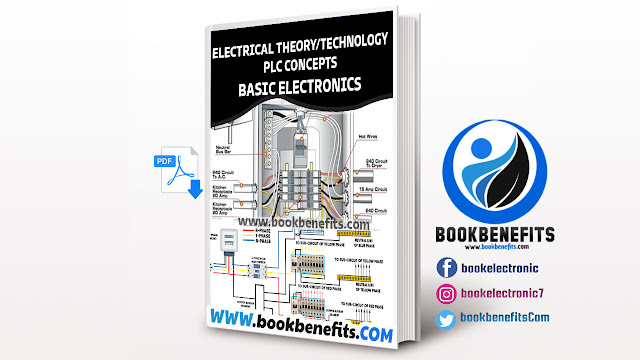Download ELECTRICAL THEORY/TECHNOLOGY
PLC CONCEPTS
BASIC ELECTRONICS PDF
ELECTRICAL THEORY/TECHNOLOGY PLC CONCEPTS BASIC ELECTRONICS
Picture of the Book:
About of The Book:
This “Study Guide” is designed to provide the electrical troubleshooter with a
review of, and the mechanical troubleshooter with an introduction of, basic
electrical skills needed for him/her to safely and more efficiently carry out their
duties in the plant environment. After successful completion, the troubleshooter
can improve their understanding of DC, AC, three phase circuits, Relays,
Contactors, PLC, Electronics, and other related technology.
The keyboard is exclusive to the unit. Electrical Theory / Basic PLC Technology Concepts of Electronics is a study guide designed to provide a basic understanding and comparison to basic practices and applications.
The book covers a wide range of topics that work in the field of electrical and widget wiring for central units and settings, giving you a thorough understanding of the key concepts in these areas. ..
Electric and electric incubators and electric and electric and electric and electric and electric and electric and electric and electric and electric. Motors, electric motors, motors, motors, and motors, as well as explain the topics of those motors.
Concepts of Unit Controls (PLCs): They can provide an introduction to unit controllers (PLCs), which are widely used in industrial control and automation systems.
MATH
To review the mathematics related to electrical theory and the application of that theory to
electrical equipment.
APPLIED ELECTRICAL THEORY
To improve the understanding and application of electrical theory related to the principles of
operation of manufacturing equipment.
1. Draw and solve for circuit parameters such as resistance, voltage, current, and power in:
- D.C. series circuits
- D.C. parallel circuits
- D.C. complex series/parallel circuits
2. Understand the properties of magnetism and how they relate to
electromagnetic concepts as applied to contactors, relays, generators, motors, and transformers
3. Explain the generation of an A.C. sinewave using the associated terms
4. Draw and solve for circuit parameters such as resistance, inductance,
inductive reactance, capacitance, capacitive reactance, impedance,
voltage, current, and power in:
- A.C. series resistive circuits
- A.C. series inductive circuits
- A.C. series capacitive circuits
- A.C. series combination RLC circuits
5. Draw transformers, explain the operating principle, and solve problems using
voltage, current, and turns relationships
6. Understand three phase concepts:
- Advantages and disadvantages
- Waveform generation
- Calculations for Wye and Delta circuits
7. Understand three phase motor concepts:
- Squirrel Cage motors
- Wound Motors
- American motor connections
- European motor connections
ELECTRICAL SCHEMATICS
To improve the understanding of the different types of electrical drawings and the use of
electrical drawings associated with trouble-shooting procedures.
1. Recognize the standard electrical schematic symbols
2. Relate symbols to the actual device
3. Use symbols and basic drawing techniques to draw valid circuits
from word descriptions
4. Use electrical schematics to determine operating cycles for machines
5. Use electrical schematics to analyze conventional machine faults
such as open circuits, ground faults, and short circuits
TROUBLE-SHOOTING PROCEDURES
To improve the understanding of safe, simple, and logical trouble-shooting procedures on
conventional relay-controlled machines.
1. Have become familiar with and practiced appropriate safety
procedures during trouble-shooting
2. Be able to locate and repair open circuit faults using a safe, efficient
procedure
3. Be able to locate and repair ground faults and short circuits using a
safe, efficient procedure
EQUIPMENT TECHNOLOGY
To improve the understanding of the operating principle of industrial input and output
devices, protection devices, ac motors, dc motors, motor brakes and other associated
electrical control devices.
1. Understand and be able to explain the operating principles of
conventional electrical components such as push buttons, limit
switches, fuses, overcurrent relays, electro-magnetic relays, and
contactors
2. Become familiar with the proper use and care of multimeters,
amprobes and megohm-meters
BASIC MATH RULES
ADDITION AND SUBTRACTION
A. To add two numbers of the same sign, add their absolute values and attach the common sign.
B. To add two numbers of opposite signs, subtract the smaller absolute value from the larger
absolute value and attach the sign of the larger.
C. To subtract signed numbers, change the sign of the number to be subtracted (subtrahend) and
add as in (A) or (B) above.
More...
Information Of the Book:
Title: ELECTRICAL THEORY/TECHNOLOGY PLC CONCEPTS BASIC ELECTRONICS Download PDF
Size: 2 Mb
Pages: 260
Year:
Format: PDF
Language: English
Author:
link download in electronic07.com

